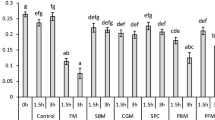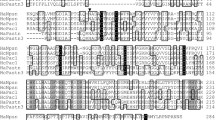Abstract
Cholecystokinin (Cck) and peptide YY (Pyy) play important roles in digestive regulation in fish, but their function in red seabream (Pagrus major) remains obscure. Two cck complementary DNAs (cck-1 and cck-2) in red seabream were identified, and tissue distribution analysis of the genes revealed that cck and pyy were expressed throughout the digestive tract, except for stomach cck-2. After feeding, cck-1 expression significantly increased in the stomach and pyloric caeca, cck-2 expression significantly increased in the pyloric caeca and hindgut, and pyy expression increased in the pyloric caeca of red seabream. After oral administration of dietary protein, i.e., high-quality fish meal (HQFM), soy protein concentrate (SPC), or low-quality FM (LQFM), only HQFM significantly increased stomach cck-1 expression. To assess the growth of red seabream in response to different sources of dietary protein, three isonitrogenous and isoenergetic diets were formulated: HQFM, SPC with a low percentage of HQFM, and LQFM. Mean body weight was highest in the HQFM group after 6 weeks. The stomach cck-1 response to HQFM may explain the high growth in the HQFM group. Our data suggest that cck-1, cck-2, and pyy are involved in digestion. Furthermore, stomach cck-1 may be a valuable tool for evaluating the quality of dietary protein sources for red seabream.









Similar content being viewed by others
References
Aksnes A, Izquierdo MS, Robaina L, Vergara JM, Montero D (1997) Influence of fish meal quality and feed pellet on growth, feed efficiency and muscle composition in gilthead seabream Sparus aurata. Aquaculture 153:251–261
Batterham R, Cowley MA, Small C, Herzog H, Batterham RL, Cowley MA, Small CJ (2002) Gut hormone PYY3-36 physiologically inhibits food intake. Nature 418:650–654
Chang W, Lee T, Shien D, Hsu JB, Horng J, Hsu P, Wang T, Huang H, Pan R (2009) Incorporating support vector machine for identifying protein tyrosine sulfation sites. Comput Chem 30:2526–2537
Chen Y, Prasad N, Fu J (2014) Identification, characterization and feeding response of peptide YYb (PYYb) gene in grass carp Ctenopharyngodon idellus. Fish Physiol Biochem 40:45–55
Daly K, Al-Rammahi M, Moran A, Marcello M, Ninomiya Y, Shirazi-Beechey SP (2013) Sensing of amino acids by the gut-expressed taste receptor T1R1-T1R3 stimulates CCK secretion. Am J Physiol Gastrointest Liver Physiol 304:G271–G282
Einarsson S, Spencer DP, Talbot C (1997) Effect of exogenous cholecystokinin on the discharge of the gallbladder and the secretion of trypsin and chymotrypsin from the pancreas of the Atlantic salmon Salmo salar L. Comp Biochem Physiol C Pharmacol Toxicol Endocrinol 117C:63–67
Food and Agriculture Organization of the United Nations (2015) Fishery and Aquaculture Department (online). National aquaculture sector overview, Japan. Food and Agriculture Organization of the United Nations, Rome. https://www.fao.org/fishery/countrysector/naso_japan/en. Accessed 11 Jul 2017
Forgan LG, Forster ME (2007) Effects of potential mediators of an intestinal brake mechanism on gut motility in Chinook salmon Oncorhynchus tshawytscha. Comp Biochem Physiol C Toxicol Pharmacol 146:343–347
Fukada H, Fujii Y, Matsumoto H, Takahashi N, Hosomi N, Morioka T, Masumoto T (2014) Quality improvement of fish feed by using insulin-like growth factor 1 as a potential indicator of amino acid deficiency in yellowtail. Aquaculture 426–427:264–269
Fukada H, Kitagima R, Shinagawa J, Morino H, Masumoto T (2019) Effects of complete replacement of fish oil with plant oil mixtures and algal meal on growth performance and fatty acid composition in juvenile yellowtail Seriola quinqueradiata. Fish Sci 86:107–118
Furutani T, Masumoto T, Fukada H (2012) Response of cholecystokinin and digestive enzyme mRNA levels to various feed ingredients in yellowtail Seriola quinqueradiata. Fish Sci 78:1075–1082
Hardy RW (2010) Utilization of plant proteins in fish diets: effects of global demand and supplies of fishmeal. Aquacult Res 41:770–776
Hossain MS, Koshio S, Ishikawa M, Yokoyama S, Sony NM, Ono S, Fujieda T (2016) Comparison of the effects of inosine and inosine monophosphate on growth, immune response, stress resistance and gut morphology of juvenile red sea bream, Pagrus major. Aquaculture 458:64–74
Hu L, Yun B, Xue M, Wang J, Wu X, Zheng Y, Han F (2013) Effects of fish meal quality and fish meal substitution by animal protein blend on growth performance, flesh quality and liver histology of Japanese seabass Lateolabrax japonicus. Aquaculture 372–375:52–61
Jensen H, Rourke IJ, Moller M, Jonson L, Johnsen AH (2001) Identification and distribution of CCK-related peptides and mRNAs in the rainbow trout, Oncorhynchus mykiss. Biochim Biophys Acta Gene Struct Expr 1517:190–201
Ji W, Ping HC, Wei KJ, Zhang GR, Shi ZC, Yang RB, Zou GW, Wang WM (2015) Ghrelin, neuropeptide Y (NPY) and cholecystokinin (CCK) in blunt snout bream (Megalobrama amblycephala): cDNA cloning, tissue distribution and mRNA expression changes responding to fasting and refeeding. Gen Comp Endocrinol 223:108–119
Karra E, Chandarana K, Batterham RL (2009) The role of peptide YY in appetite regulation and obesity. J Physiol 587:19–25
Kondo F, Ohta T, Iwai T, Ido A, Miura C, Miura T (2017) Effect of the squid viscera hydrolysate on growth performance and digestion in the red sea bream Pagrus major. Fish Physiol Biochem 835:1543–1555
Kumar S, Stecher G, Tamura K (2016) MEGA7: molecular evolutionary genetics analysis version 7.0 for bigger datasets. Mol Biol Evol 33:1870–1874
Kurokawa T, Suzuki T (2002) Development of neuropeptide Y-related peptides in the digestive organs during the larval stage of Japanese flounder, Paralichthys olivaceus. Gen Comp Endocrinol 126:30–38
Kurokawa T, Suzuki T, Hashimoto H (2003) Identification of gastrin and multiple cholecystokinin genes in teleost. Peptides 24:227–235
Liddle RA (2000) Regulation of cholecystokinin secretion in humans. J Gastroenterol 35:181–187
Lundberg JM, Tatemoto K, Terenius L, Hellstrom M, Mutt V, Hokfelt T (1982) Localization of peptide YY (PYY) in gastrointestinal endocrine cells and effects on intestinal blood flow and motility. Proc Natl Acad Sci Physiol Sci 79:4471–4475
Mashima J, Kodama Y, Fujisawa T, Katayama T, Okuda Y, Kaminuma E, Ogasawara O, Okubo K, Nakamura Y, Takagi T (2017) DNA Data Bank of Japan. Nucleic Acids Res 45:25–31
Mendieta-Zerón H, López M, Diéguez C (2008) Gastrointestinal peptides controlling body weight homeostasis. Gen Comp Endocrinol 155:481–495
Micale V, Campo S, D’Ascola A, Guerrera CM, Levanti MB, Germana A, Muglia U (2012) Cholecystokinin in white sea bream: molecular cloning, regional expression, and immunohistochemical localization in the gut after feeding and fasting. PLoS One 7:1–10
Murashita K, Fukada H, Hosokawa H, Masumoto T (2006) Cholecystokinin and peptide Y in yellowtail Seriola quinqueradiata: molecular cloning, real-time quantitative RT-PCR, and response to feeding and fasting. Gen Comp Endocrinol 145:287–297
Murashita K, Fukada H, Hosokawa H, Masumoto T (2007) Changes in cholecystokinin and peptide Y gene expression with feeding in yellowtail Seriola quinqueradiata: relation to pancreatic exocrine regulation. Comp Biochem Physiol B Biochem Mol Biol 146:318–325
Murashita K, Fukada H, Rønnestad I, Kurokawa T, Masumoto T (2008) Nutrient control of release of pancreatic enzymes in yellowtail Seriola quinqueradiata: involvement of CCK and PY in the regulatory loop. Comp Biochem Physiol A Mol Integr Physiol 150:438–443
Murashita K, Kurokawa T, Nilsen TO, Rønnestad I (2009) Ghrelin, cholecystokinin, and peptide YY in Atlantic salmon Salmo salar: molecular cloning and tissue expression. Gen Comp Endocrinol 160:223–235
Murphy KG, Bloom SR (2004) Gut hormones in the control of appetite. Exp Physiol 15:507–516
Murphy KG, Dhillo WS, Bloom SR (2006) Gut peptides in the regulation of food intake and energy homeostasis. Endocr Rev 27:719–727
Nguyen HP, Khaoian P, Takahiro K, Nagano J, Fukada H, Masumoto T (2017) Effects of alcohol extract of defatted soybean meal on growth performance and digestive physiology of yellowtail Seriola quinqueradiata. Fish Sci 83:99–106
Nielsen H (2017) Predicting secretory proteins with SignalP. Method Mol Biol 1611:59–73
Nishi T, Hara H, Hira T, Tomita F (2001) Dietary protein peptic hydrolysates stimulate cholecystokinin release via direct sensing by rat intestinal mucosal cells. Exp Boil Med 226:1031–1036
Nishi T, Hara H, Tomita F (2003) Soybean β-conglycinin peptone suppresses food intake and gastric emptying by increasing plasma cholecystokinin levels in rats. J Nutr 133:352–357
Olsson C, Aldman G, Lason A, Holmgren S (1999) Cholecystokinin affects gastric emptying and stomach motility in the rainbow trout Oncorhynchus mykiss. J Exp Biol 202:161–170
Pfaffl M (2001) A new mathematical model for relative quantification in RT-PCR. Nucleic Acids Res 29:2002–2007
Raybould HE (2007) Mechanisms of CCK signaling from gut to brain. Curr Opin Pharmacol 7:570–574
Satoh S, Porn-Ngam N, Takeuchi T, Watanabe T (1996) Influence of dietary phosphorus levels on growth and mineral availability in rainbow trout. Fish Sci 62:483–487
Sharara AI, Bouras EP, Misukonis MA, Liddle RA (1993) Evidence for indirect dietary regulation of cholecystokinin release in rats. Am J Physiol 265:G107–G112
Tola S, Fukada H, Masumoto T (2019) Effects of feeding a fish meal—free soy protein concentrate—based diet on the growth performance and nutrient utilization of red sea bream (Pagrus major). Aquacult Res 50:1087–1095
Volkoff H (2014) Appetite regulating peptides in red-bellied piranha, Pygocentrus nattereri: cloning, tissue distribution and effect of fasting on mRNA expression levels. Peptides 56:116–124
Volkoff H (2015) Cloning and tissue distribution of appetite-regulating peptides in pirapitinga Piaractus brachypomus. J Anim Physiol Anim Nutr (Berl) 99:987–1001
Volkoff H, Estevan R, Eurico J, Cyrino P (2016) Appetite regulating factors in dourado, Salminus brasiliensis: cDNA cloning and effects of fasting and feeding on gene expression. Gen Comp Endocrinol 237:34–42
Volkoff H, Esatevan Sabioni R, Coutinho LL, Cyrino JEP (2017) Appetite regulating factors in pacu (Piaractus mesopotamicus): tissue distribution and effects of food quantity and quality on gene expression. Comp Biochem Physiol Part A Mol Integr Physiol 203:241–254
Wang BJ, Cui ZJ (2007) How does cholecystokinin stimulate exocrine pancreatic secretion? From birds, rodents, to humans. Am J Physiol Integr Comp Physiol 292:R666–R678
Watanabe T, Nanri H, Satoh S, Takeuchi M, Nose T (1983) Nutritional evaluation of brown meals as a protein source in diets for rainbow trout. Nippon Suisan Gakkaishi 49:1083–1087
Yan P, Jia J, Yang G, Wang D, Sun C, Li W (2017) Duplication of neuropeptide Y and peptide YY in Nile tilapia Oreochromis niloticus and their roles in food intake regulation. Peptides 88:97–105
Acknowledgment
We thank Feed One for donating the protein sources and experimental diets. The authors declare no conflict of interest.
Author information
Authors and Affiliations
Corresponding author
Additional information
Publisher's Note
Springer Nature remains neutral with regard to jurisdictional claims in published maps and institutional affiliations.
Rights and permissions
About this article
Cite this article
Huong, T.T.M., Murashita, K., Senzui, A. et al. Cholecystokinin 1 and 2 in red seabream Pagrus major: molecular cloning, response to feeding, and a potential indicator of dietary protein source quality. Fish Sci 86, 835–849 (2020). https://doi.org/10.1007/s12562-020-01443-z
Received:
Accepted:
Published:
Issue Date:
DOI: https://doi.org/10.1007/s12562-020-01443-z




